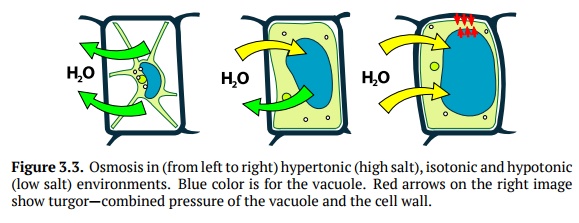Chapter: Introduction to Botany: Symbiogenesis and the Plant Cell
Cell wall, Vacuoles, and Plasmodesmata
Cell wall, Vacuoles, and Plasmodesmata
Among eukaryotic cells, plant cells are largest.
Some of them (for example, cells from green pepper and grapefruit) are well
visible with the naked eye. Plant cells do not have well-developed internal
cytoskeleton, but cell wall provides
an external one. There are two kinds (or, better, two stages of development) of
cell walls, the primary and the secondary. The primary cell wall is
typically flexible, frequently thin and is made of cellulose, different
carbohydrates and proteins. The secondary cell wall contains also lignin and highly hydrophobic suberin. These chemicals completely
block the exchange between the cell andthe environment which means that the
cell with secondary wall will soon die. Dead cells can still be useful to
plants in many ways, for example as a defense against herbivores, support and
water transport. In fact, more than 90% of wood is dead.

Since every plant cell is surrounded with a cell
wall, they need a specific way of communication. This is done through plasmodestata—thin cytoplasmic bridges
between neighbor cells. A symplast
is the name of continuous cytoplasm in-side of cells. An apoplast is cell walls and space outside the cell where
com-munication and considerable metabolic activity take place. Both the
symplast and apoplast are important to the transportation of nutrients needed
by the cell (Fig. 3.6).
If cells are surrounded by a smaller
concentration of salts than in the cytoplasm, the water will flow into the
cell. This process is called osmosis.
In plant cells, most of the water with diluted chemicals is concentrated in
vacuole(s). Turgor pressure is the
combined pressure of the cell and vacuoles wall that supports the shape of cell
(Fig. 3.3).

You may think of plant tissue as about staked
cardboard boxes where every box is made from wet cardboard paper (cell wall)
but has the inflated balloon (vacuole) inside.
Comparing with animal cells, plant cells have
chloroplasts, vacuoles, cell walls, and plasmodesmata but they hardly have any
phagocytosis and true cytoskele-ton. They are easy to explain: animals do not
photosynthesize (no chloroplasts), instead, they need to move quickly (no cell
walls and plasmodesmata); animals will support the shape of cell from
cytoskeleton (no need for vacuole turgor sys-tem) and use molecular pumps to
counterpart the osmosis.
Related Topics